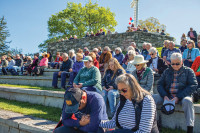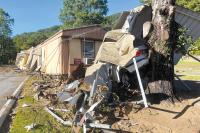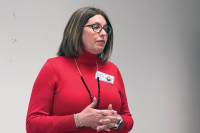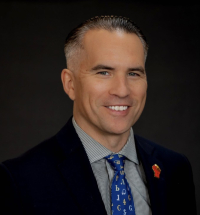Working to preserve ‘Cherokee Traditions’
 By Anna Fariello • Guest Editorial
By Anna Fariello • Guest Editorial
In writing the text for an exhibition on Cherokee culture a few years ago, I began with this opening line, “Chances are, where you are standing is part of the Cherokee’s ancestral lands.” While, perhaps, I should have hesitated to make such a bold claim of an exhibit that was traveling throughout Western North Carolina, that statement was far from rash. Today, many think of Cherokee as a town at the entrance to the Great Smoky Mountains National Park, while in fact, Cherokee lands once extended to portions of eight modern states.
When The Smoky Mountain News asked me to write this guest editorial, I was in the midst of putting the finishing touches on a talk for Western Carolina University’s annual Native Expo (9 a.m. to 9 p.m. Nov. 12). The expo takes place every November to celebrate and share native cultures with students and the community. Events include talks, film, language, music, and art that celebrate indigenous culture as the university’s contribution to Native American Heritage Month. This year, among other events, the Hunter Library mounted a tribute to the late Robert J. Conley, a prolific and talented writer who served for three years as the university’s Distinguished Sequoya Professor.
In Western North Carolina, we are extremely fortunate to live nearby to the Qualla Boundary. Not a reservation in the usual sense, the Boundary is land retained by the Eastern Band, rather than land assigned to them by the federal government. This is a rare situation in a country that displaced the majority of its original inhabitants. In the 18th and 19th centuries, when much of this displacement took place, there was little appreciation for other cultures. Few incoming settlers thought that there was anything to learn from cultures that differed from their own. Even in the face of Removal, the Cherokee were unafraid of cultural interaction. Overhill country resident, Ostenaco, travelled to London in the 1760s. The Cherokee Phoenix published in 1828 — the first ever newspaper in a native tongue — carried articles in both English and Cherokee. Their baskets were traded to Euro-American settlers, influencing an artform shared with Appalachian neighbors and future generations. There are many more examples of how cultural difference provides a richness to human experience, much like the variation that exists across our landscape and the change in our seasons.
The Eastern Band has invested in its own cultural institutions as a means to share and interact with its members, neighbors, and tourists. The Oconaluftee Indian Village, Museum of the Cherokee, Qualla Arts and Crafts, and Unto these Hills are cultural attractions that amplify Western North Carolina’s culture. Swain, Jackson, and Macon counties are extremely fortunate to have indigenous heritage sites within their borders. Kituwah Mound is the site of the Cherokee’s motherland; Judacualla Rock provides quiet contemplation along Caney Fork Creek; Nikwasi Mound reminds us that preservation is possible even in the midst of a bustling town center.
What can we learn about the connection of language to thinking from those who are revitalizing a spoken language? What can we learn about the value of family ties, so important to people of this place? Will we be swallowed up by globalization or can we hold onto cultural identity? How can we use technology to sustain and nurture our environment for the future? While much evidence of past cultures has been lost to development, and to ignorance, I remind myself that there is still much to preserve. And while culture is certainly valued by those who produce it, its value is as important — maybe more so — to those of us who live outside it.
Related Items
Anna Fariello is the curator of Western Carolina University’s “Cherokee Traditions,” an online collection housed at Hunter Library. She is author of Cherokee Basketry, Cherokee Pottery, and Cherokee Carving and is an associate professor at Western Carolina University.
Want to go?
The presentation “Cherokee Traditions: From the Hands of our Elders” will be held at 7 p.m. Thursday, Nov. 20, at the Macon County Public Library in Franklin.
Anna Fariello, craft project director at the Western Carolina University Hunter Library, will host the discussion. “Cherokee Traditions” begins with an overview of Cherokee crafts, focusing on the key material traditions of basketry, pottery and carving. The highly visual program then recognizes early 20th Century artisans, the Elders who have kept these traditions alive.
This Road Scholars program is made possible in part by a grant from the North Carolina Humanities Council, a statewide nonprofit and affiliate of the National Endowment for the Humanities.
Sponsored by the Arts Council of Macon County.
828.524.3600 or www.wcu.edu/library/digitalcollections/cherokeetraditions.









